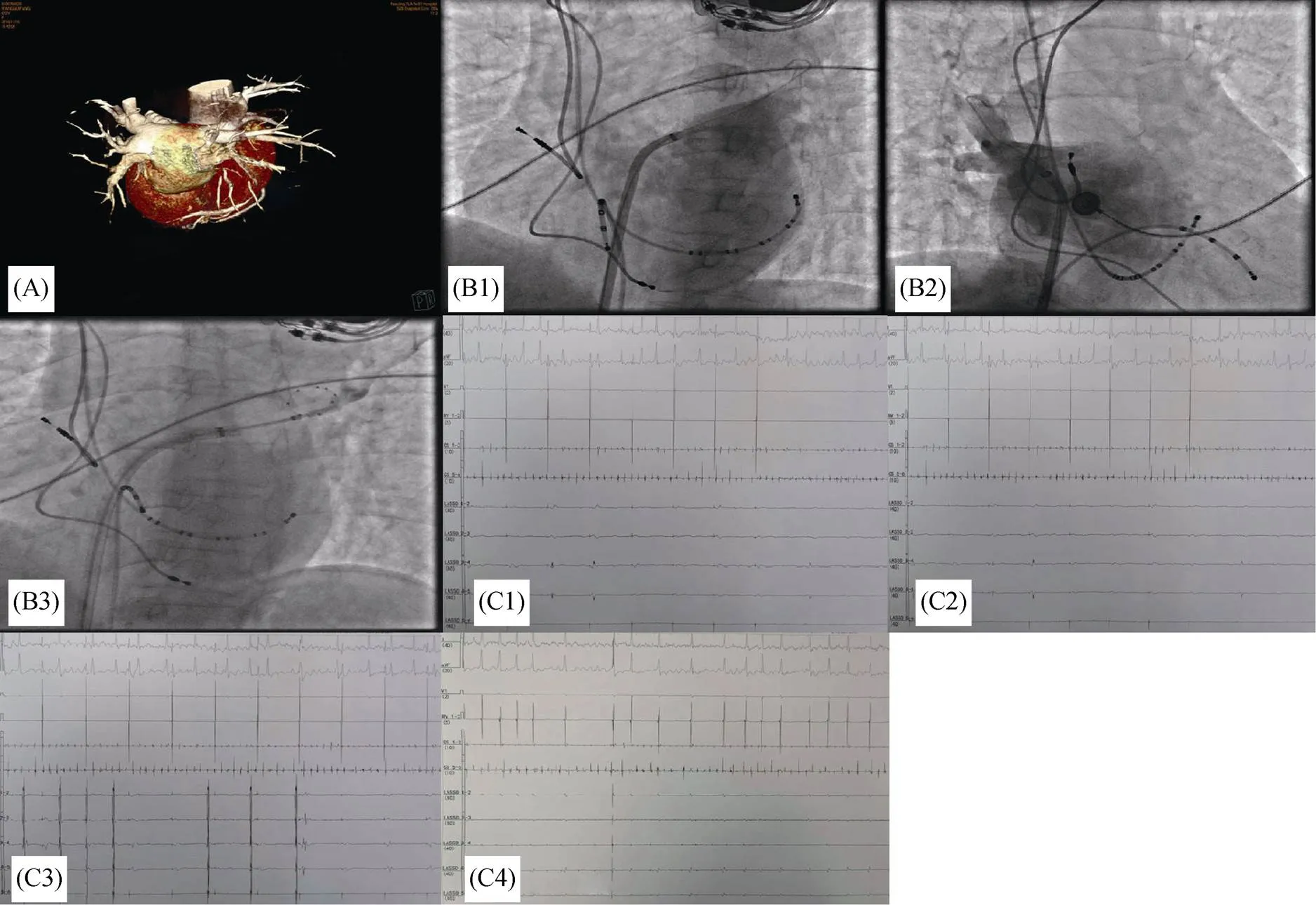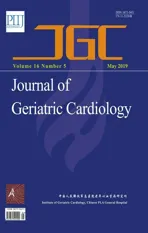Cryoballoon ablation on an elder paroxysmal atrial fibrillation patient implanted with double chamber pacemaker: a case report
2019-06-12YuXUYanFangZHAO
Yu XU, Yan-Fang ZHAO
Cryoballoon ablation on an elder paroxysmal atrial fibrillation patient implanted with double chamber pacemaker: a case report
Yu XU, Yan-Fang ZHAO*
Section of Cardiology, Jinling Hospital, Nanjing 210002, JiangSu, China
2019; 16: 434436. doi:10.11909/j.issn.1671-5411.2019.05.005
Atrial fibrillation; Cryoballoon; Double chamber pacemaker
Atrial fibrillation (AF) is the most common sustained cardiac arrhythmia, increasing in prevalence with age. Catheter ablation is recommended to symptomatic paroxysmal AF refractory or intolerant to at least one Class I or III antiarrhythmic medication.[1]Main current catheter ablation of AF with radiofrequency can give priority to, other include freezing, ultrasonic and laser ablation etc. Recent studies provides substantial information regarding the efficacy and safety of novel cryoballoon technology in creating pulmonary vein (PV) isolation.[2,3]Processed in cyroballoon ablation, some AF patients implanted with double chamber pacemaker are difficult to puncture atrial septal, because of the atrial electrode. My case report was as follows.
A 72-years-old female without hypertension, diabetes, presented with 30 years history of paroxysmal palpitation. Instantly, ECG captured AF. In 2011, the patient was implanted with double chamber pacemaker because of sinus arrest reported in dynamic ECG. Amiodarone, propafenone anti-arrhythmic treatment did not control the onset of AF effectively. Coronary computed tomography angiography (CTA) demonstrated mild stenosis of proximal right coronary artery (RCA), and coronary myocardial bridge of middle left anterior descending artery (LAD). Pacemaker stored program control revealed for VVIR pacemaker mode. Trans-thoracic echocardiography (TTE) showed left atrium end-diastolic diameter was 3.1 cm. Before cyroballoon isolation, Left atrial and pulmonary vein (PV) CTA was performed. No obvious filling defected in the atrioventricular cavity, meanwhile, both sides of the pulmonary vein coursed naturally (Figure 1A). Preoperatively, the patient was given rivaroxaban (20 mg q.d.) for 15 days, but withdrawal it on procedure day.
After puncturing left and right femoral vein and the left subclavian vein, the hemostatic sheaths were placed in veins. A 5-F decapolar catheter (HuiTai Inc.) was advanced to the coronary sinus for anatomical guidance. A 5-F quadripolar catheter was positioned at the right ventricular (RV)/superior vena cava (SVC) junction for high-output pacing of the phrenic nerve. Atrial septal puncture sheath (SAL 1stJude Inc.) was inserted through the right femoral vein, that was performed by Multi-position fluoroscopy, avoiding the atrial electrode. Selective PV angiography was performed through the atrial septal puncture sheath by hand injection of 20 mL of contrast medium into the targeted vein (Figure 1B1-B2). After 15-F FlexCathTM sheath (Medtronic Inc.) was replaced, the Achieve mapping catheter (Medtronic Inc.) was inserted into PV, while the second-generation cryoballoon (Medtronic Inc.) was inflated to the PV orifice. A complete occlusion is typically confirmed by injecting contrast in the lumen at the balloon tip (Figure 1B3). In the ablation procession, PVs potential were recorded continuously (Figure C1-C4). The parameters of PVs ablation were shown in Table 1.
The patient did not cardiovert during the cryoablation, but to sinus rhythm by being injected of 70 mg propafenone after the operation. TTE was re-examined one month later, which confirmed the diameter of left anterior was 2.8 cm.
The first-generation CB (Medtronic Inc.) has received FDA approval in 2010. It consisted of a non-compliant balloon available in two different diameters (23 mm and 28 mm) and utilized N2O as the refrigerant.[4]Neumann, et al.[5]evaluated the efficacy of cryoballoon ablation in 293 patients with paroxysmal and 53 patients with persistent AF. Ninety-seven percent of the PVs were isolated with either cryoballoon alone or in combination with a standard cryocatheter. Maintenance of sinus rhythm was reported in 74% and 42% of the patients with paroxysmal and persistent AF, respectively. Security of the last generation CB embodied in the low incidence of pulmonary vein stenosis, cardiac tamponade rate and the rate of stroke, but due to its low temperature area was limited to balloon equatorial area, that cause poor adhesion with the PV orifice, which resulting in the failure of pulmonary vein isolation. In order to overcome this problem, a second-generation cryoballoon (Arctic Front AdvanceTM, Medtronic) was developed with a redesigned injection system wherein the injection coil was moved 4-5 mm towards the nose and the number of injection ports were increased from four to eight. A spiral-mapping catheter (AchieveTM, Medtronic Inc, USA) can be passed through the catheter to stabilize the balloon and to record pulmonary vein potentials.[6]

Figure 1. (A): Left atrial and pulmonary vein CTA; (B1): the left pulmonary vein angiography; (B2): the right pulmonary vein angiography; (B3): a complete occlusion in pulmonary vein is typically confirmed by injecting contrast in the lumen at the balloon tip; (C1): left superior pulmonary vein potential disappeared; (C2): left inferior pulmonary vein potential disappeared; (C3): right superior pulmonary vein potential disappeared; (C4): right inferior pulmonary vein potential disappeared. CTA: computed tomography angiography.

Table 1. The parameters of cryoballoon ablation.
LSPV: left superior pulmonary vein; LIPV: left inferior pulmonary vein; RSPV: right superior pulmonary vein; RIPV: right inferior pulmonary vein; TTI: time to isolation.
Compared to the traditional radiofrequency ablation for the treatment of AF technique, the benefits of cryoballoon ablation technology were time saving, good tolerance, high success rate, low recurrence rate and low incidence of complications such of cardiac tamponade, atrial esophageal fistula. Reproducibly high acute PVI rates of 92%-100% were demonstrated.[7]The most comprehensive result regarding the efficacy and safety of the cryoballoon ablation for the treatment of AF was obtained from the STOP-AF trial. Balloon-only isolation of PVs was achieved in 90.8%, and the overall procedural success (≥ 3PVs isolated) was achieved in 98.2% of the patients. The success rate at 1-year follow up was 69.9%.[8]
A trial was confirmed the safety and efficacy of radiofrequency catheter ablation on paroxysmal AF patients implanted with double chamber pacemaker. The program of circumferential pulmonary vein ablations (CPVA) with supplementary line ablation in necessity were done. The result of the study demonstrated CPVA guided by CARTO system can decrease atrial arrhythmia and improve left atrial function in patients with pacemaker.[9]The success of the case manifested that cryoballoon catheter ablation was effective and safe in elderly AF patients implanted pacemaker.
1 Calkins H, Hindricks G, Cappato R,. 2017 HRS/EHRA/ ECAS/APHRS/SOLAECE expert consensus statement on catheter and surgical ablation of atrial fibrillation: Executive summary. Europace.2018; 20: 157–208.
2 Sarabanda AV, Bunch TJ, Johnson SB,. Efficacy and safety of circumferential pulmonary vein isolation using a novel cryothermal balloon ablation system.2005; 46: 1902–1912.
3 Avitall B, Urboniene D, Rozmus G,. New cryotechnology for electrical isolation of the pulmonary veins.2003; 14: 281–286.
4 Reissmann B, Metzner A, Kuck KH. Cryoballoon ablation versus radiofrequency ablation for atrial fibrillation.2017; 27: 271–277.
5 Neumann T, Vogt J, Schumacher B,. Circumferential pulmonary vein isolation with the cryoballoon technique. Results from a prospective 3-center study.2008; 52: 273–278.
6 Shakkottai P, Sy RW, MeGuire MA,. Cryoablation for atrial fibrillation in 2017. What have we learned?2017; 26: 950–959.
7 Andrade JG, Khairy P, Guerra PG,. Efficacy and safety of cryoballoon ablation for atrial fibrillation: a systematic review of published studies.2011; 11: 1828– 1835.
8 Packer DL, Irwin JM, Champagne J,. Cryoballoon ablation of pulmonary veins for paroxysmal atrial fibrillation: first results of the North American Arctic Front stop-AF clinical trial.2013; 61: 1713–1723.
9 ZHAO Yu-Jie, YUAN Yi-Qiang. [Safety and effectiveness of radiofrequency catheter ablation on paroxysmal atrial fibrillation patients implanted with double chamber pacemaker].2010; 24: 518–520. [In Chinese].
yanfangz@sina.com
杂志排行
Journal of Geriatric Cardiology的其它文章
- Clinical significance of diabetes on symptom and patient delay among patients with acute myocardial infarction—an analysis from China Acute Myocardial Infarction (CAMI) registry
- Feasibility and safety of robotic PCI in China: first in man experience in Asia
- Protective effect of Danhong injection in patients with acute myocardial infarction at a high risk of no-reflow during primary percutaneous coronary intervention
- Heart failure with preserved ejection fraction in the elderly: pathophysiology, diagnostic and therapeutic approach
- The Harvard method of Tau calculation is incorrect
- Conduction disorder and primary cardiac tumor: a fatal case of multiple lipomas of the right atrium
